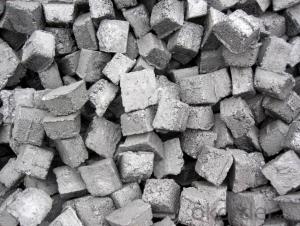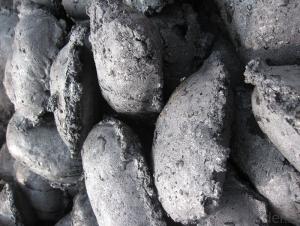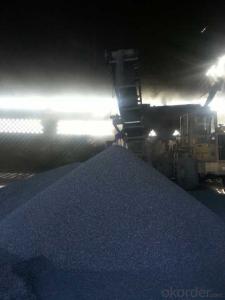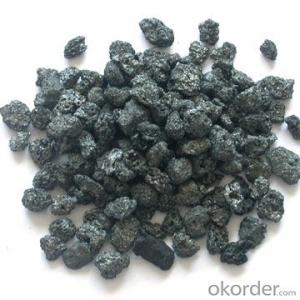Iron Alloy Application Carbon Electrode Paste Block
- Loading Port:
- Lianyungang
- Payment Terms:
- TT OR LC
- Min Order Qty:
- 20 m.t.
- Supply Capability:
- 1000 m.t./month
OKorder Service Pledge
OKorder Financial Service
You Might Also Like
Spcifications
Iron Alloy Application Carbon Electrode Paste Block
1:carbon eletrode paste
2:for ferroalloy,calcium carbide manufacture
3:HS 3801300000,YB/T5212-1996,ISO9001:2008
Product Description
Iron Alloy Application Carbon Electrode Paste Block
Carbon Electrode Paste is a self-baking electrode used in submerged arc furnaces for delivering power to the charge mix. Electrode Paste is added to the top of the electrode column in either cylindrical or briquette form. As the paste moves down the electrode column the temperature increase causes the paste to melt and subsequently bake forming a block of electrically conductive carbon. Electrode Paste is essentially a mix of Electrically Calcined Anthracite (ECA) or Calcined Petroleum Coke (CPC) with Coal Tar Pitch.
Product Feature
Iron Alloy Application Carbon Electrode Paste Block
Ash 4.0%max5.0%max 6.0%max7.0% Max9.0% Max11.0% Max
VM 12.0%-15.5%12.0%-15.5%12.0%-15.5%9.5.0%-13.5%11.5%-15.5%11.5%-15.5%
Strength
Compress 18.0Mpa Min17.0Mpa Min15.7Mpa Min19.6Mpa Min19.6Mpa Min19.6Mpa Min
Specific 65μΩm Max68μΩm Max75μΩm Max80μΩm Max90μΩm Max90μΩm Max
Resistance
Bulk Density1.38G/CM3 Min1.38G/CM3 Min1.38G/CM3 Min1.38G/CM3 Min1.38G/CM3 Min1.38G/CM3 Min
Product Picture
Iron Alloy Application Carbon Electrode Paste Block
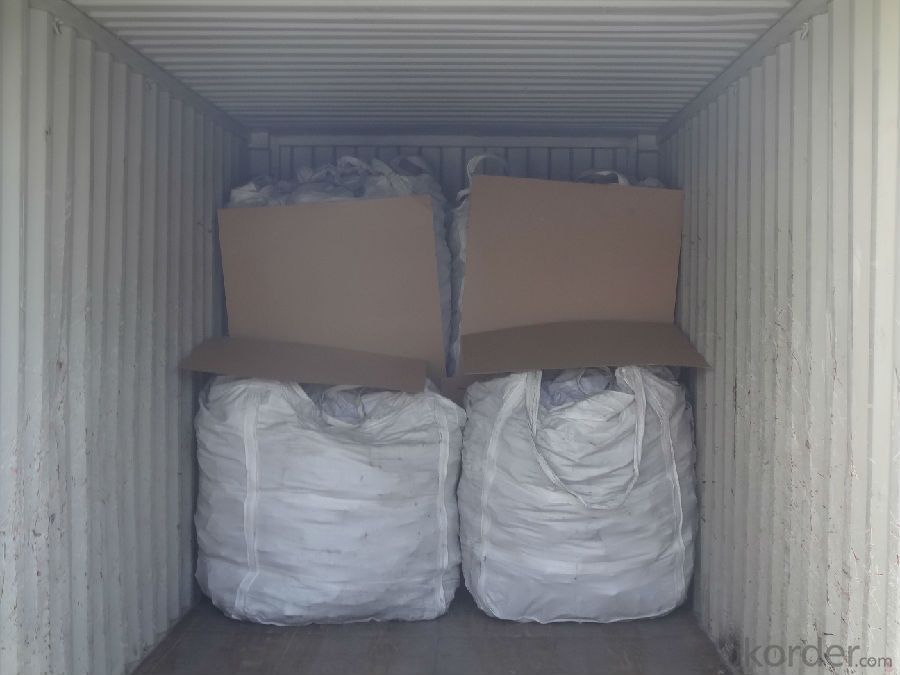

FAQ:
Iron Alloy Application Carbon Electrode Paste Block
What's our advantage? Why choose us?
1.High quality and competitive price.
2.Timely delivery.
3.If any item you like. Please contact us.
- Q:What are carbon sinks?
- Carbon sinks are natural or artificial reservoirs that absorb and store carbon dioxide from the atmosphere. They play a crucial role in mitigating climate change by reducing the concentration of greenhouse gases in the atmosphere. Carbon sinks can be found in various forms, including forests, oceans, wetlands, and soil. Forests are the largest and most well-known carbon sinks. Through the process of photosynthesis, trees absorb carbon dioxide and convert it into oxygen, storing the carbon in their trunks, branches, and roots. Oceans are also significant carbon sinks, as they absorb about a quarter of the carbon dioxide emitted by human activities. Algae, phytoplankton, and other marine organisms capture carbon through photosynthesis and convert it into biomass. Wetlands, such as marshes and swamps, are another important carbon sink. These areas store enormous amounts of carbon in their vegetation and soil, preventing it from being released back into the atmosphere. Additionally, soil acts as a carbon sink by absorbing and storing carbon through the decomposition of organic matter and the action of microorganisms. Artificial carbon sinks, like carbon capture and storage (CCS) technologies, are being developed to further combat climate change. CCS involves capturing carbon dioxide emissions from power plants and industrial facilities and storing them underground or repurposing them for other uses. While these technologies are still in the early stages, they have the potential to significantly reduce carbon emissions and help stabilize the climate. Overall, carbon sinks are essential for maintaining the balance of carbon dioxide in the atmosphere and preventing its accumulation, which would contribute to global warming. Preserving and restoring natural carbon sinks, such as forests and wetlands, is crucial for mitigating climate change, while developing and implementing artificial carbon sinks can further aid in reducing greenhouse gas emissions.
- Q:What's the difference between blue and red Panasonic batteries (carbon)?
- Blue is leak, proof, general, Purpose, general use battery (leak proof)Red is the long life long life battery (suitable for watches and clocks and other small power appliances)And heavy duty green seems to be good for high power appliances, such as toy cars
- Q:What are carbon offsets?
- Carbon offsets are a way to compensate for greenhouse gas emissions by supporting projects that reduce or remove carbon dioxide from the atmosphere, such as reforestation or renewable energy initiatives. They essentially enable individuals or organizations to balance out their carbon footprint by investing in activities that counteract their own emissions.
- Q:Carbon 60 related information
- Discovery and structural features of carbon sixtyIn October 7, 1996, the Royal Swedish Academy of Sciences decided to award the 1996 Nobel prize for chemistry to Robert FCurl, Jr (USA), Harold WKroto (UK) and Richard ESmalley (USA) in recognition of their discovery of C60.In early September 1995, Rice University of Texas Smalley lab, Kroto etc. in order to form the process simulation of carbon clusters N near the red giant in the atmosphere, the laser gasification experiment of graphite. They found that there is a series formed by an even number of carbon atoms from the molecular mass spectra, which have a 20~25 times larger than the other peak peak, the peak corresponding to the quality of the number of molecules formed by 60 carbon atoms.What structure of C60 molecules can be stabilized? Layered graphite and diamond tetrahedral structure exists in the form of two kinds of stable carbon, when 60 carbon atoms arranged in any of them, there will be many dangling bonds, will be very lively, not showing the mass signal so stable. This shows that the C60 molecule has a completely different structure from graphite and diamond. Inspired by architect Buckminster Fuller composed of pentagons and hexagons dome building, Kroto thinks that C60 is composed of 60 spherical carbon atoms with 32 sides, i.e. 12 pentagons and 20 hexagons, so there is no double bond in C60 molecule.In C60 molecules, each carbon atom with three carbon atoms in SP2 hybrid orbitals and the adjacent connected, a hybrid P track did not participate in the remaining in the C60 shell periphery and the cavity formed spherical PI key, thus having aromatic. In honor of Fuller, they proposed the use of Buckminsterfullerene to name C60. Later, all the molecules containing even numbered carbon, including C60, were called Fuller, and the name was fullerene.
- Q:What is the role of carbon in photosynthesis?
- The role of carbon in photosynthesis is essential. Carbon dioxide (CO2) is one of the primary reactants in the process of photosynthesis. During photosynthesis, plants and other photosynthetic organisms use carbon dioxide along with water and sunlight energy to produce glucose (a simple sugar). This glucose serves as the main source of energy for the plant's growth and development. Carbon dioxide enters the leaf through tiny pores called stomata and diffuses into the chloroplasts, where photosynthesis takes place. Inside the chloroplasts, carbon dioxide combines with water in the presence of sunlight and chlorophyll to undergo a series of chemical reactions known as the Calvin cycle or the dark reactions. In this cycle, glucose is synthesized and stored as a source of energy for the plant. The carbon atoms from carbon dioxide are the building blocks of glucose and other organic compounds formed during photosynthesis. Through a complex series of enzymatic reactions, carbon dioxide is converted into carbohydrates, lipids, proteins, and nucleic acids, which are essential for the plant's growth and survival. Photosynthesis not only helps in the production of glucose but also plays a significant role in the global carbon cycle. It is the process through which plants remove carbon dioxide from the atmosphere and release oxygen as a byproduct. This helps in regulating the levels of carbon dioxide in the atmosphere, mitigating climate change, and maintaining the oxygen balance necessary for all living organisms. In summary, carbon plays a crucial role in photosynthesis by serving as the raw material for the synthesis of glucose and other organic compounds. It is through this process that plants convert carbon dioxide into energy-rich molecules, contributing to their growth, survival, and the overall balance of carbon in the Earth's atmosphere.
- Q:How does carbon affect the pH of water?
- Carbon does not directly affect the pH of water. However, when carbon dioxide dissolves in water, it forms carbonic acid, which lowers the pH of the water, making it slightly more acidic.
- Q:What are the different types of carbon-based concrete additives?
- There are several different types of carbon-based concrete additives, including carbon fibers, carbon nanotubes, and graphene.
- Q:What is the role of carbon in the formation of fossil fuels?
- The role of carbon in the formation of fossil fuels is crucial. Fossil fuels, such as coal, oil, and natural gas, are formed from the remains of ancient plants and organisms that lived millions of years ago. These organisms were primarily made up of carbon-based compounds. Over time, the organic matter accumulated and was buried under layers of sediment, subjected to intense heat and pressure. This process, known as carbonization, caused the carbon within the organic matter to undergo chemical changes, transforming it into fossil fuels. Therefore, carbon is the key element involved in the formation of fossil fuels.
- Q:What are the impacts of carbon emissions on the stability of coastal areas?
- Carbon emissions have significant impacts on the stability of coastal areas, posing various challenges to the environment and communities residing in these regions. One of the most prominent impacts is sea-level rise, caused by the melting of polar ice caps and thermal expansion of seawater due to rising global temperatures. As carbon dioxide and other greenhouse gases accumulate in the atmosphere, they trap heat, leading to the warming of the planet. This, in turn, causes glaciers and ice sheets to melt, contributing to the rising sea levels. Sea-level rise poses a direct threat to coastal areas, resulting in increased erosion, coastal flooding, and the loss of valuable land. As water levels rise, the shoreline retreats, eroding beaches and cliffs, and endangering coastal infrastructure and habitats. This erosion not only threatens the stability of coastal ecosystems but also puts human settlements at risk, leading to the displacement of communities and loss of property. Moreover, the increase in carbon emissions leads to ocean acidification, whereby the excess carbon dioxide is absorbed by the ocean, resulting in a decrease in its pH levels. Acidic waters have detrimental effects on marine life, including coral reefs, shellfish, and other marine organisms that rely on calcium carbonate for their shells and skeletons. As the acidity of the ocean increases, these organisms struggle to form and maintain their protective structures, leading to the degradation of coastal ecosystems and the loss of biodiversity. Another impact of carbon emissions on coastal areas is the intensification of extreme weather events, such as hurricanes and tropical storms. Warmer ocean temperatures provide more energy for these storms, making them more powerful and destructive. These events can cause extensive damage to coastal infrastructure, including buildings, roads, and utility systems. Furthermore, they can result in the loss of lives and livelihoods, exacerbating the vulnerability of coastal communities. In summary, carbon emissions have far-reaching impacts on the stability of coastal areas. Sea-level rise, ocean acidification, and intensified extreme weather events all contribute to the degradation of coastal ecosystems, loss of biodiversity, erosion, and coastal flooding. These impacts not only threaten the environment but also pose significant risks to human settlements, requiring urgent mitigation and adaptation measures to protect coastal areas and the communities that rely on them.
- Q:How does carbon impact the formation of smog?
- Carbon plays a significant role in the formation of smog as it is one of the main contributors to the formation of ground-level ozone. When carbon-based pollutants, such as vehicle exhaust and industrial emissions, react with sunlight and other pollutants in the atmosphere, they undergo a complex chemical reaction leading to the production of smog. This smog not only poses health risks to humans but also harms the environment by contributing to climate change and damaging ecosystems.
1. Manufacturer Overview |
|
|---|---|
| Location | |
| Year Established | |
| Annual Output Value | |
| Main Markets | |
| Company Certifications | |
2. Manufacturer Certificates |
|
|---|---|
| a) Certification Name | |
| Range | |
| Reference | |
| Validity Period | |
3. Manufacturer Capability |
|
|---|---|
| a)Trade Capacity | |
| Nearest Port | |
| Export Percentage | |
| No.of Employees in Trade Department | |
| Language Spoken: | |
| b)Factory Information | |
| Factory Size: | |
| No. of Production Lines | |
| Contract Manufacturing | |
| Product Price Range | |
Send your message to us
Iron Alloy Application Carbon Electrode Paste Block
- Loading Port:
- Lianyungang
- Payment Terms:
- TT OR LC
- Min Order Qty:
- 20 m.t.
- Supply Capability:
- 1000 m.t./month
OKorder Service Pledge
OKorder Financial Service
Similar products
New products
Hot products
Hot Searches
Related keywords
